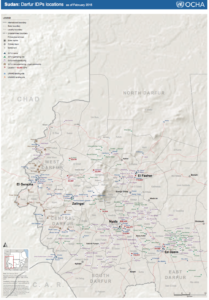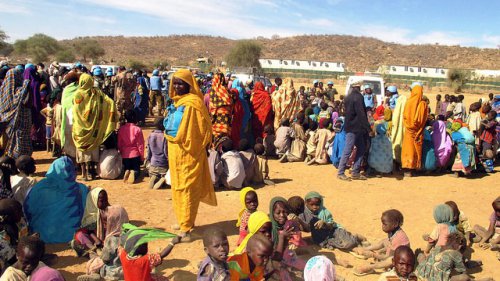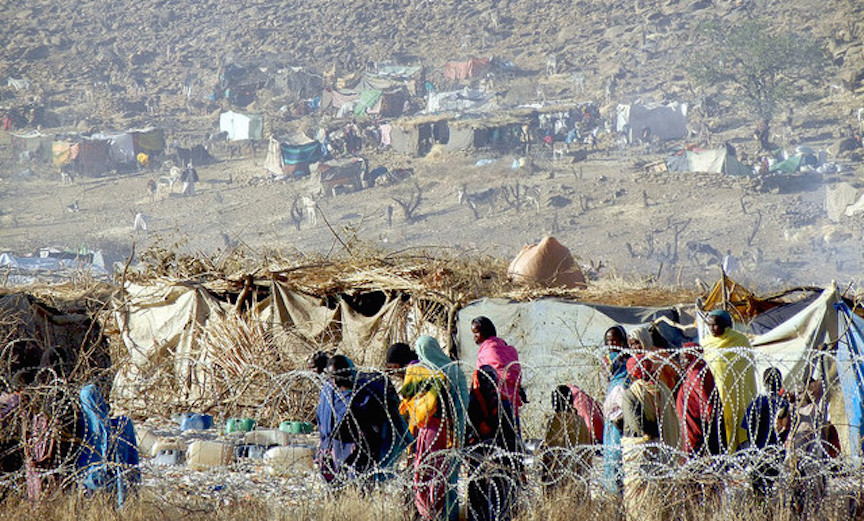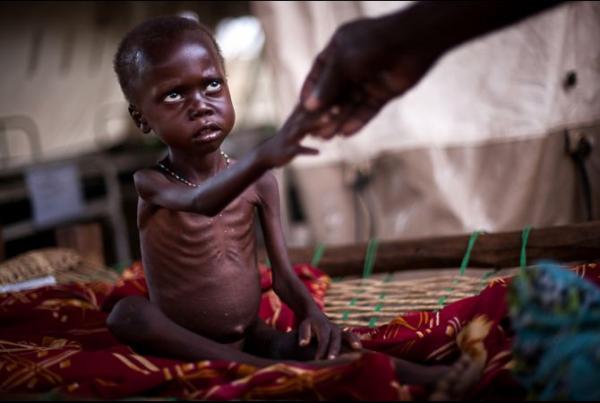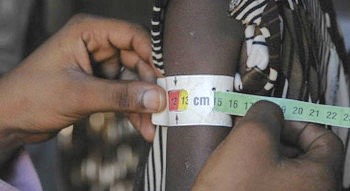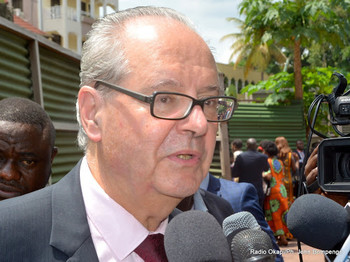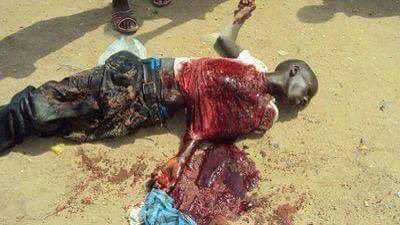Click twice on map for maximum expansion
Map of Internally Displaced Persons in Darfur (UN Office for the Coordination of Humanitarian Affairs, February 2015) | http://reliefweb.int/sites/reliefweb.int/files/resources/Darfur_IDPs_Locations_A3_A1_Feb_2015.pdf
Internally Displaced Persons in Darfur: The invisible catastrophe, international complicity
Eric Reeves | March 19, 2017 | http://wp.me/p45rOG-21N
Darfur Basics
There are many elements to the current critically dangerous situation on the ground in Darfur:
[1] Rampant insecurity, increasingly created by irregular and unchecked Arab militia forces;
[2] Denial of humanitarian access (to perhaps 30 percent of the population in need according to some humanitarian estimates); the needy population is estimated to be 3 million human beings according to the most recent OCHA figures and denial of access may thus be affecting some 900,000 people;
[3] A regional economy that is collapsing with the broader economy in Sudan, fueled in large measure by inflation that now exceeds 50 percent on a year-over-year basis (even the Khartoum regime is compelled by glaring price realities to allow the Central Bureau of Statistics to promulgate an unsustainable inflation rate of 33 percent for February 2017);
[4] Threats by Khartoum to begin dismantling camps, throwing many hundreds of thousands of people into a highly insecure environment without organized relief assistance;
[5] And the increasing likelihood that the UN/African Union “hybrid” peacekeeping mission in Darfur (UNAMID) will be drastically reduced when the continuation of its mandate, as well as its size, is debated by the UN Security Council this coming June (2017).
Khartoum has made no secret of its insistence that UNAMID be withdrawn, and has in the nine years the mission has been officially deployed repeatedly attacked the personnel of the Mission through proxy militia forces and is overwhelming responsible for the violent deaths of more than 200 military personnel (for a survey of the evidence pointing to Khartoum’s responsibility in the most serious violent assault on UNAMID forces, see my analysis of May 9, 2013 | http://wp.me/p45rOG-11S). If UNAMID withdraws or is cut even more severely than it has to date (to only 70 percent of the originally mandated force size), this will be a signal to remaining humanitarian organizations that whatever protection might have been provided by this disastrously conceived and poorly performing Mission will disappear—and they will withdraw.
Human Displacement in Darfur
At the center of all of that continues to make this one of the great humanitarian crises in the world today is the massive fact of displacement: some 3 million people—roughly 2.7 million Internally Displaced Persons and some 300,000 Darfuri refugees in eastern Chad cannot return to their homes. These people are overwhelming from the non-Arab/African tribal groups of Darfur, as are the more than 500,000 people who have died directly or indirectly from the violence that has been continuous for the past fourteen years (see | http://wp.me/p45rOG-AB/).
- The current OCHA figure for the number of IDPs in Darfur is “up to 2.6 million” (“as of December 2015”) (all additions of bold are mine—ER) | http://reliefweb.int/sites/reliefweb.int/files/resources/OCHA_Sudan_Weekly_Humanitarian_Bulletin_Issue_47_%2814_-20_November_2016%29.pdf/). But this figure, likely not fully inclusive in any event, certainly does not include those displaced during the massive Jebel Marra offensive mounted by Khartoum in 2016, using both regular military forces (the Sudan Armed Forces, SAF) and the militia force of choice, the Rapid Support Forces (RSF), now officially incorporated into the SAF. As many as 200,000 newly displaced persons were created by this brutal assault, distinguished by its savagery and its use of chemical weapons. Many of these people fled north to what has become the Sortony IDP camp (North Darfur), near the UNAMID base as this location; many fled to the west or south; and many have returned. Given the absence of other data—an absence expertly engineered by the Khartoum regime—a better estimate of the number of IDPs is 2.7 million.
• The figure of 300,000 Darfuri refugees in eastern Chad was conveyed to me by officials of the UN High Commission for Refugees in researching my account of this shamefully neglected population last April (2016): “Invisible, Forgotten, and Suffering: Darfuri Refugees in Eastern Chad.”
Images of displacement in Darfur
Darfuri refugees in eastern Chad
The map above is the most recent representation of internally displaced persons (IDPs) in Darfur by the UN Office for the Coordination of Humanitarian Affairs (OCHA) (February 2015). A close analysis of the map reveals why humanitarian access is such a critical issue in Darfur, and why it is so challenging. While there are ten concentrations of IDPs greater than 50,000 in size, there are 208 locations in which IDPs are in camps, gathering points that are not yet camps, and host communities. They are widely scattered in an enormous geographical expanse. Darfur as a whole is the size of Spain, although the northern half of the region is very sparsely populated, this still leaves an area of some 250,000 square kilometers over which a highly vulnerable and needy population is spread.
Humanitarian workers are also widely distributed, and hence extremely vulnerable: http://reliefweb.int/sites/reliefweb.int/files/resources/Darfur_Presence_of_Aid_Workers_in_National_%26_International_Organisations_A3_1_Jan_2017.pdf
Were UNAMID to withdraw, some of these locations would become immediately a great deal more insecure, and relief organizations might themselves withdraw; all of them have contingency plans for rapid withdrawal and re-location of their workers (97 percent of whom are Sudanese nationals and highly vulnerable). Even with the presence of UNAMID, displaced persons are extremely vulnerable and are attacked on a widespread and frequent basis, often by Khartoum’s regular forces. Very recently Radio Dabanga reported:
Security force “storms” South Darfur camp
March 10, 2017 (Nyala) | A joint force of police and security has stormed Kalma camp for displaced people in South Darfur, causing unrest in the camp and a number of residents to flee this week. Three vehicles with Dushka machineguns mounted on top entered Kalma, east of Nyala, at 3.30pm on Thursday, the spokesman for a Darfuri refugee association reported to Radio Dabanga. Hussein Abu Sharati of the Association for the Displaced People and Refugees in Darfur said that another group of security agents had stormed the camp at 11am, using a tinted Land Cruiser. “Their arrival caused panic among the residents. “They did not notify UNAMID prior to their arrival,” he said, pointing out the camp administration has therefore submitted a memorandum to the peacekeeping force to condemn the incidents.
But this is nothing new. This same Kalma camp was attacked in 2008 in deadly fashion (see my Wall Street Journal article “Now Sudan Is Attacking Refugee Camps” (September 6, 2008, co-authored with Mia Farrow | https://www.wsj.com/articles/SB122065894281205691/):
At 6 a.m. on the morning of Aug. 25 [2008], Kalma camp, home to 90,000 displaced Darfuris, was surrounded by Sudanese government forces. By 7am, 60 heavily armed military vehicles had entered the camp, shooting and setting straw huts ablaze. Terrified civilians—who had previously fled their burning villages when they were attacked by this same government and its proxy killers the Janjaweed—hastily armed themselves with sticks, spears and knives. Of course, these were no match for machine guns and automatic weapons. By 9pm, the worst of the brutal assault was over. The vehicles rolled out leaving scores dead and over 100 wounded. Most were women and children.
Many other camps have been attacked with the same brutality—often with UNAMID personnel very nearby. Notably, Kalma camp—which now has a population of 126,000 according to the UN—is close to Nyala, the largest city in Darfur. A survey of the IDP map above reveals just how far many camps are from urban areas, which significantly increases their vulnerability.
Vulnerability to Malnutrition
Food insecurity and malnutrition in Darfur have been quantified, but the UN has often refused to released the assembled data. The most striking instance of this was a UNICEF report on malnutrition in Sudan that revealed shocking data on Chronic Malnutrition (also known as “stunting”), Acute Malnutrition, and Severe Acute Malnutrition. The report—still unpublished—was leaked to Nicholas Kristof of the New York Times, who published it on September 5, 2014. The findings are as shocking as the fact that UNICEF refused to promulgate the report in order to comply with Khartoum’s wishes. Among the most telling figure:
“Acute malnutrition rates for children in Sudan among the highest in the world”
North Darfur: 28 percent acute malnutrition among children
South Darfur: 18 percent acute malnutrition among children
East Darfur: 15 percent acute malnutrition among children
South Darfur: 13 percent acute malnutrition among children
West Darfur: 8 percent acute malnutrition among children
“Chronic malnutrition among children is widespread and pervasive”
[A graph in the report indicates the following figures for chronic malnutrition among children in Sudan—ER]:
Central Darfur: 45 percent
East Darfur: 40 percent
West Darfur: 35 percent
North Darfur: 35 percent
South Darfur: 26 percent
[The report indicates that the World Health Organization cutoff point for “high” prevalence of chronic malnutrition is 30 percent, and for “very high” prevalence > = 40 percent. Source: S3m Survey, 2013] [See also Save the Children’s Acute Malnutrition Summary Sheet—ER]
[A third chart indicates]:
“% of under-fives moderately or severely wasted in the 10 most affected countries”
[Sudan ranked 4th from the bottom in this category in 2010—ER]:
Wasting prevalence for country population under five:
Moderate or severe wasting: 16 percent
Severe wasting: 5 percent
[Two percent is the “emergency” threshold for Severe Acute Malnutrition (SAM) among children; in developing countries, even in hospital settings, some 20 – 30 percent of all children suffering from SAM die—ER]
A child suffering from Acute Malnutrition in the Nuba Mountains
The most recent Sudan Bulletin from UN OCHA indicates that the “Global Acute Malnutrition Burden” (or “Caseload”) for Sudan as a whole has ticked upward to 2.2 million people | http://reliefweb.int/sites/reliefweb.int/files/resources/OCHA_Sudan_Humanitarian_Bulletin_Issue_07_%2827_February_-_12_March_2017%29.pdf?).
Measuring a child’s level of malnutrition: why can’t this data be promulgated?
This reflects not only the Khartoum regime’s relentless hostility to international relief aid (many hundreds of thousands of civilians in rebel-controlled areas of South Kordofan and Blue Nile are denied all humanitarian access), but the grotesque mismanagement of the economy by the National Islamic Front/National Congress Party. Inflation, verging on hyper-inflation, is symptomatic; but just as significant has been the refusal of the regime to devote national resources to the rehabilitation and modernization of the agricultural sector, which should be the backbone of the Sudanese economy, given the vast tracts of arable land in this still geographically immense country.
The International Community and Darfur’s Displaced
Despite the horrific realities facing roughly half the population of the Darfur region, the most consequential international actors now refuse to acknowledge the scale of the ongoing crisis (in Darfur, this phrase is not an oxymoron). These include the political side of the UN (and in the past the humanitarian side as well); the African Union, which has spoken only mendaciously about Darfur; the U.S., which lifted sanctions on the Khartoum regime during the last week of the Obama administration (citing a “sea change” in improved humanitarian access); and the European Union, best represented by a recent statement by EU Ambassador Jean-Michel Dumond, as reported by Radio Dabanga:
“Situation in Darfur improved”: EU diplomat | February 12, 2017 | EL FASHER
The security and humanitarian situation in Darfur has significantly improved, according to the head of the EU Delegation to Sudan. On Wednesday, in a meeting of EU ambassadors with the North Darfur government in El Fasher, EU Ambassador Jean-Michel Dumond said that the EU stays committed to the projects commenced under the auspices of the Darfur Regional Authority (DRA). The mandate of the DRA ended in July last year. The EU Ambassador noted that the security and humanitarian situation in Darfur has significantly improved. He stated that the Union has many commitments in the region, of which the most important are the peace process, stability, and development issues.
EU Ambassador Jean-Michel Dumond, the face of European mendacity
We might wonder whether Ambassador Dumond knew that he was being led on a guided tour organized and overseen by Military Intelligence, which has long had the security file in Darfur. Did he realize that everything he and his delegation saw was what the Khartoum regime wanted him to see and nothing that it did not want him to see? How can he generalize about the humanitarian and security situation based on such a “Potemkin Village” experience? How can his generalization be made to square with the realities detailed above? Does Dumond actually know anything about these realities? Does he care? It is very difficult to believe he does, especially in light of the EU’s desperate, and finally despicable desire to make friends with the Khartoum regime in order to stanch the flow of African migrants (see a remarkable exposé on this subject by Der Spiegel in May 2016 | http://wp.me/p45rOG-1Tt/).
Darfur Tomorrow
Khartoum has largely succeed in its genocidal counter-insurgency in Darfur, with only pockets of resistance from the once powerful rebel movements. But violence continues on a vast scale, largely by irregular Arab militias and small armed groups, which Khartoum refuses to control. To be sure, as the attack on Kalma and the “Nertiti massacre” of early January 2017 make clear, government-controlled security elements are still capable of outrageous violence, and this will intensify with the eventual closing of the camps—something Khartoum has made fully explicit it intends to accomplish, and not in the distant future.
Victim of the Nertiti massacre, January 2017; not mentioned by EU Ambassador Jean-Michel Dumond
Darfur’s displaced, whether inside camps or in an unimaginably threatening environment without any meaningful international presence, will in the vast majority of cases never return to their homes. The immense and violent expropriation of African farmlands by Arab militia forces and other armed Arab groups has effected permanent changes in the demographic geography of Darfur—and come close to fulfilling the ambitions announced by notorious Janjaweed leader Musa Hilal in a directive from his Misteriya headquarters in August 2004: “change the demography” of Darfur and “empty it of African tribes” (http://wp.me/p45rOG-1Oo/).
Musa Hilal—the face of evil
That such ambitions have been realized over the course of the past fourteen years, with continuous if now highly attenuated reporting, makes clear that genocide as a national security policy is alive and well in Khartoum.
